Close Encounters of the Buddhist Kind
Captions by Ron Gluckman, photos by Luke Duggleby, Foreign Policy, Washington, DC, January 20, 2011
|
An exclusive look inside a booming multibillion-dollar, evangelical, global Thai cult. |
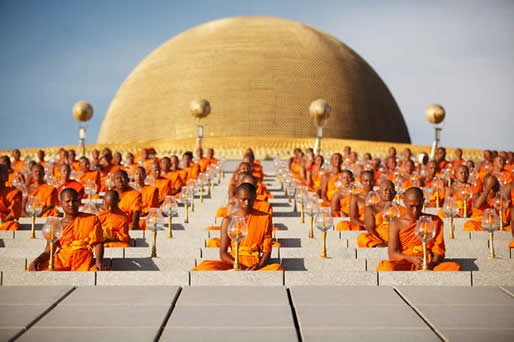 |
Picture this: millions of followers gathering around a central shrine that looks like a giant UFO in elaborately choreographed Nuremberg-style rallies; missionary outposts in 31 countries from Germany to the Democratic Republic of the Congo; an evangelist vision that seeks to promote a "world morality restoration project"; and a V-Star program that encourages hundreds of thousands of children to improve "positive moral behavior." Although the Bangkok-based Dhammakaya movement dons saffron robes, not brown shirts, its flamboyant ceremonies have become increasingly bold displays of power for this cult-like Buddhist group that was founded in the 1970s, ironically, as a reform movement opposed to the excesses of organized religion in Thailand.
Yet, despite the pageantry, the inner workings of this fast-growing movement are little known to Thailand's general public, and certainly to the rest of the world, though its teachings loom large among the legions of devotees. The veil of secrecy parted briefly in late 1999, when two top Dhammakaya leaders were charged with embezzlement in what many considered a political ploy to suppress the temple's growing power. The charges were dismissed in 2006 after the former abbot and a colleague returned some land and nearly 1 billion baht ($32 million) to temple control.
This obscurity is because -- despite its 24-hour satellite TV station -- Dhammakaya has diligently worked to avoid the limelight. Until now. Over the past year, photographer Luke Duggleby and reporter Ron Gluckman have been granted unrivaled access to the facilities and ceremonies of Dhammakaya, and they provide an exclusive look at this mesmerizing movement. |
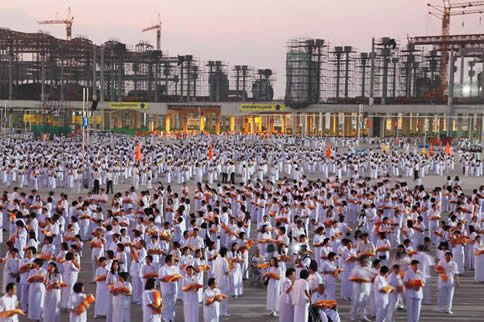 |
| Dressed in white, family members join the celebration at Wat Phra Dhammakaya and prepare for the presentation of saffron robes to some 30,000 men who will soon become monks in a mass ordination on Feb. 6, 2010. The temple, or wat in Thai, began modestly as a reform movement on 80 acres of acidic rice paddy land in 1970, but has boomed in the last 20 years. |
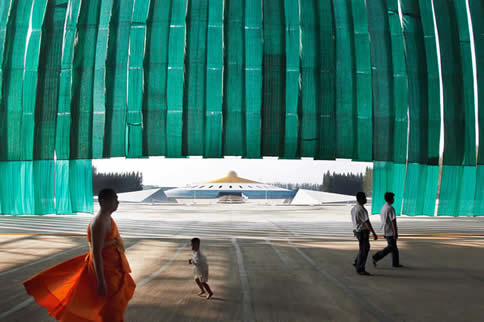 |
| The Mothership: The gold-topped Cetiya temple is the center of the Dhammakaya's expanding global meditation movement and the focal point of ceremonies. The dome is actually composed of 300,000 identical titanium- and gold-coated bronze statues of Buddha -- another 700,000 are nestled inside a temple that even devotees will admit looks like a UFO. Some call it "The Mothership." Estimates have placed the value of the temple complex at around $1 billion. |
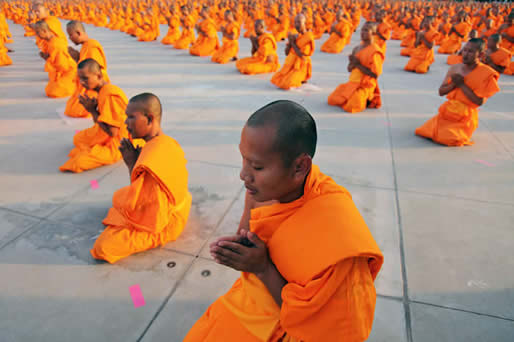 |
| Now monks, the men begin their new path to self-awareness and enlightenment by praying. This will be a major part of their lives for as long as they choose to remain monks. Life in the monastery begins before dawn with morning prayers and continues long after dark, with study and work service. |
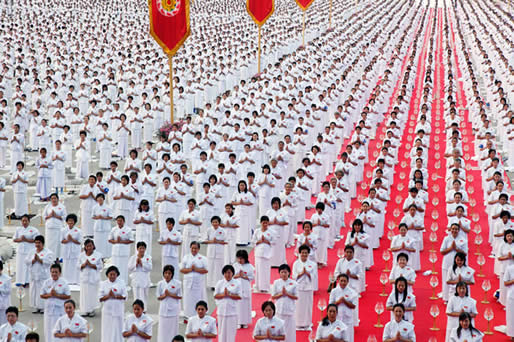 |
| On what was promoted as the largest gathering of its kind in history, the Upasika Kaew culminated with a mass meditation with a claimed attendance of 1 million women. An estimate of 100,000 to 200,000 actually attended, but thousands more watched on the Dhammakaya's satellite network and joined in on the meditation at over 100 centers around the globe. |
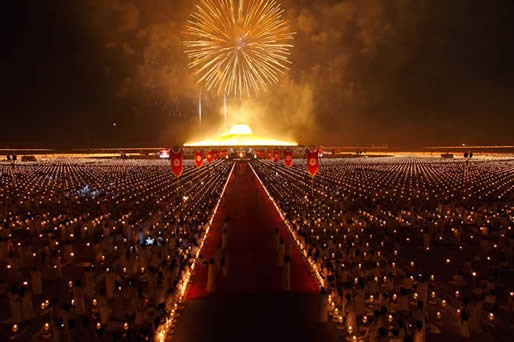 |
| Fireworks provide a Disney-esque touch to the culmination of the massive Buddhist gathering on Dec. 25, 2010. |
|
 Home
Home Archives
Archives




